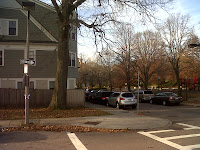

My favorite part about Jamaica Plain so far is what you see when you step out of the Green Street T stop's northwest exit: a park and an apartment building (see the photos to the left). Then, you walk west on Green for 10 minutes and the only buildings on either side -- with one small exception, for a nearly socialist printing press -- are residential. Only after 10 minutes do you reach Centre Street, the neighborhood's commercial district.
JP is a neighborhood in reverse -- the subway stop is surrounded by quiet, attractive residential streets and the business strip is hard to reach. In Boston's historical context this is understandable because the right of way that became the Orange Line and the Southwest Corridor Park above it was originally intended for an elevated highway. No one wanted to build anything there, most especially a business, in the late 1960s, but then Massachusetts' governor at the time, Francis Sargent, did something very innovative in U.S. transportation policy: He listened to intense community opposition, declined to build the highway, stopped building all highways in metro Boston's core, and opted instead to allocate the federal money for mass transit, which was a historical first for such a change. (This is yet another reason why Boston is a very interesting place to work in urban design, development and planning.) Now, JP is one of the city's most desirable places to live.
One of my colleagues joked that JP is Boston's Portland, Ore., aka "the place that young people go to retire." I like to joke that it's a glorified suburb -- so many older couples, families with younger children, and cool 20-somethings at the mediocre Asian restaurant on a Friday night! But if it's a glorified suburb, it's the coolest one there is, with quite the exciting mix of people and a commitment to keep it this way. That a place can accommodate hipsters, well-off stroller-pushers, grizzled gentrifiers circa 1986, and working-class families at the same time -- and function so well -- raises the question: Why can't all suburbs be like this? I think if they all had four T stops, such that you were never more than 15-minute walk from one, they would be.
No comments:
Post a Comment